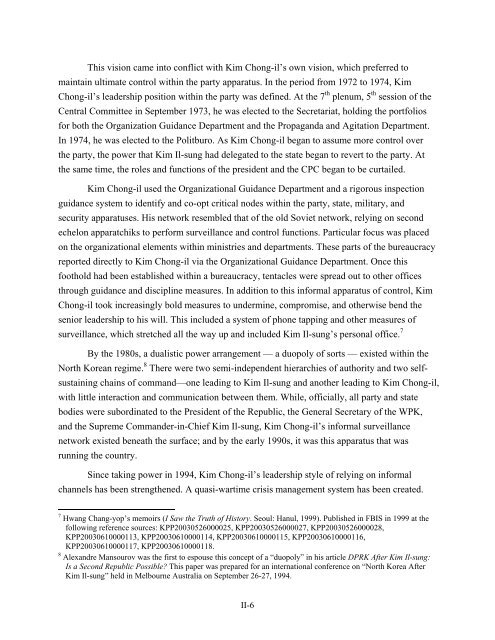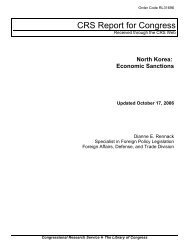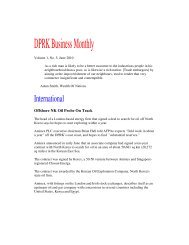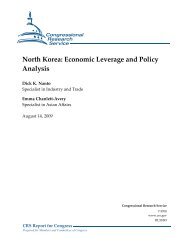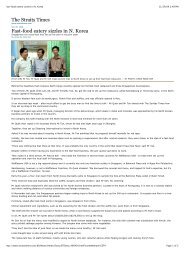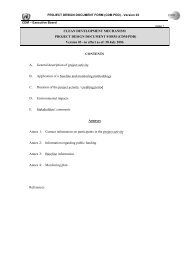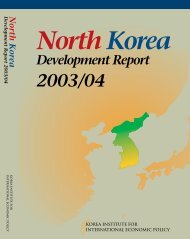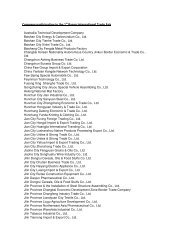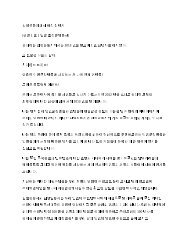North Korean Policy Elites - Defense Technical Information Center
North Korean Policy Elites - Defense Technical Information Center
North Korean Policy Elites - Defense Technical Information Center
Create successful ePaper yourself
Turn your PDF publications into a flip-book with our unique Google optimized e-Paper software.
This vision came into conflict with Kim Chong-il’s own vision, which preferred to<br />
maintain ultimate control within the party apparatus. In the period from 1972 to 1974, Kim<br />
Chong-il’s leadership position within the party was defined. At the 7 th plenum, 5 th session of the<br />
Central Committee in September 1973, he was elected to the Secretariat, holding the portfolios<br />
for both the Organization Guidance Department and the Propaganda and Agitation Department.<br />
In 1974, he was elected to the Politburo. As Kim Chong-il began to assume more control over<br />
the party, the power that Kim Il-sung had delegated to the state began to revert to the party. At<br />
the same time, the roles and functions of the president and the CPC began to be curtailed.<br />
Kim Chong-il used the Organizational Guidance Department and a rigorous inspection<br />
guidance system to identify and co-opt critical nodes within the party, state, military, and<br />
security apparatuses. His network resembled that of the old Soviet network, relying on second<br />
echelon apparatchiks to perform surveillance and control functions. Particular focus was placed<br />
on the organizational elements within ministries and departments. These parts of the bureaucracy<br />
reported directly to Kim Chong-il via the Organizational Guidance Department. Once this<br />
foothold had been established within a bureaucracy, tentacles were spread out to other offices<br />
through guidance and discipline measures. In addition to this informal apparatus of control, Kim<br />
Chong-il took increasingly bold measures to undermine, compromise, and otherwise bend the<br />
senior leadership to his will. This included a system of phone tapping and other measures of<br />
surveillance, which stretched all the way up and included Kim Il-sung’s personal office. 7<br />
By the 1980s, a dualistic power arrangement — a duopoly of sorts — existed within the<br />
<strong>North</strong> <strong>Korean</strong> regime. 8 There were two semi-independent hierarchies of authority and two selfsustaining<br />
chains of command—one leading to Kim Il-sung and another leading to Kim Chong-il,<br />
with little interaction and communication between them. While, officially, all party and state<br />
bodies were subordinated to the President of the Republic, the General Secretary of the WPK,<br />
and the Supreme Commander-in-Chief Kim Il-sung, Kim Chong-il’s informal surveillance<br />
network existed beneath the surface; and by the early 1990s, it was this apparatus that was<br />
running the country.<br />
Since taking power in 1994, Kim Chong-il’s leadership style of relying on informal<br />
channels has been strengthened. A quasi-wartime crisis management system has been created.<br />
7 Hwang Chang-yop’s memoirs (I Saw the Truth of History. Seoul: Hanul, 1999). Published in FBIS in 1999 at the<br />
following reference sources: KPP20030526000025, KPP20030526000027, KPP20030526000028,<br />
KPP20030610000113, KPP20030610000114, KPP20030610000115, KPP20030610000116,<br />
KPP20030610000117, KPP20030610000118.<br />
8 Alexandre Mansourov was the first to espouse this concept of a “duopoly” in his article DPRK After Kim Il-sung:<br />
Is a Second Republic Possible? This paper was prepared for an international conference on “<strong>North</strong> Korea After<br />
Kim Il-sung” held in Melbourne Australia on September 26-27, 1994.<br />
II-6


